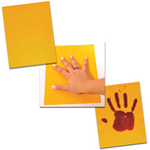 Talk about sure-fire discussion starters! Halloween is a prime time for demonstrations that will leave your students dazzled, curious… and maybe just a wee bit scared. Even your most reluctant learners will be excited to find how what’s going on with these spooky science demos. What we refer to as “discrepant events,” they might simply call AWESOME! We like to think of it as going from Wow!! to How??
Talk about sure-fire discussion starters! Halloween is a prime time for demonstrations that will leave your students dazzled, curious… and maybe just a wee bit scared. Even your most reluctant learners will be excited to find how what’s going on with these spooky science demos. What we refer to as “discrepant events,” they might simply call AWESOME! We like to think of it as going from Wow!! to How??
If you have a favorite spooky science lesson or activity, please share it with us at socialmedia@teachersource.com.
Bloody Handprint
Tape a piece of yellow goldenrod paper to the board. Dip your hand into a shallow container of baking or washing soda and water. Then, when you press your hand against the paper, you will leave a “bloody” hand-print.
For more goldenrod paper experiments, we refer you to master teacher Ron Perkins’ blog of simple and advanced activities. And don’t forget to stock up!
Levitating Chain
Is there anything spookier than levitation? Most levitation stunts are just tricks, but we have stumbled upon a strange physics effect that allows a chain to seemingly jump out of a glass! Take a look at our very own Polymer Bead Demo. Just add some creepy music and a few abracadabra incantations, and you’ll persuade onlookers that you really CAN bring an inanimate object to life!
(But later, make sure you explain the science behind the demo!)
Wiggling Worms
What happens if you soak gummy worms in a base solution (baking soda and water) and then set them loose in a bowl of acid solution (like seltzer or white vinegar)? Carbon dioxide… and bubbling worms!
Edible Experiments
Anything that glows in the dark is already cool, but how about EDIBLE glow-in-the-dark experiments? The secret, we’ve learned, is tonic water, which contains quinine.* Like other fluorescent substances, quinine absorbs ultraviolet light and then re-emits it. The light emitted has a longer wavelength than the one absorbed, which makes the light visible. When you substitute tonic water for regular tap water in a recipe, it adds the quinine which adds the glow.
Other foods that glow naturally include mint, bananas and even honey. Why not organize a blacklight classroom Halloween feast? Students will love using the scientific method to determine which foods give off the brightest glow!
A few of our favorite recipes:
Glow in the dark Jello
Glow-in-the-dark cupcakes
* Because it is an unusual ingredient, and many people have not heard of quinine allergy, a footnote seemed justified. Tonic water contains quinine, which causes an allergic reaction in a small percentage of people. Drinking tonic is no more inherently risky than eating other foods with allergens like nuts, meat, fish, eggs, wheat.
We Have Spooky Science on the Brain!
Even if we didn’t sell the plastic mold used to make the Jell-O brain, we would still think this is a SPOOK-tacular idea!
(By the way, long after Halloween is over, this brain mold can be used in a Biology class or even in a Health / Phys Ed setting. Our free lesson offers essential information on how a person’s skull (and athletic helmet) protects the brain.
